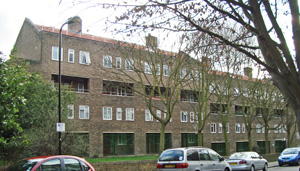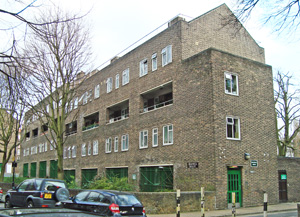St Peter's Home
Mortimer Road, Kilburn, NW6 5UT
Medical
dates:
Medical
character:
Convalescent
In 1869 St Peter's Home moved from its original premises at Nos. 27 and 48 Brompton Square to Mortimer Road in Kilburn.
The Home was run by the Sisters of the Community of St Peter, an Anglican religious order which was devoted to nursing. The Community had been founded in 1861 in Brompton by Benjamin Lancaster, a wealthy businessman and a Governor of St George's Hospital, and his wife Rosamira. The Lancasters were concerned about ladies who had been discharged from the Hospital, but were still in 'bad health and narrow circumstance' and in need of convalescent care.
By 1869 the Lancasters had spent £40,000 on the Community. (When Mr Lancaster died in 1897, he left them £30,000 in his will.)
The new Home had 12 beds. It admitted only women and children. The Sisterhood also undertook mission work for the poor in the locality, and taught young girls how to be domestic servants.
The low church Vicar of the local St Mary's parish gave the Community no encouragement, and even banned the celebration of the Eucharist in the Convent's chapel. Therefore the Sisters attended services at other local churches, such as St Mark's in Hamilton Terrace and St Mary Magdalene in Paddington. In 1871 the temporary church of St Augustine's opened and the Sisters were welcomed there by Fr Kirkpatrick, who gave them all the help they needed.
By 1878 the Community consisted of a Lady Superior, four Sisters and a limited number of Serving Sisters. Patients were received from several hospitals and nursed until restored to health.
In 1883 the Sisterhood was given some land in Woking by Mrs Matilda Blanche Gibbs (1817-1887), the wife of a wealthy businessman in Wraxall, Somerset (the Sisters had looked after the Gibbs' youngest daughter until her death in 1874). The site was used to build a long-term care home with 60 beds. This opened on 20th October 1885 as St Peter's Memorial Home. A wing was added in 1892; it contained two wards and 8 single rooms 'for ladies who require nursing'.
In 1892 a group of the Sisters went out to Korea to set up an orphanage and a mission there.
In 1898 the weekly charge of an in-patient was 14 shillings (70p). Washing, wine and brandy were extra.
By the early 20th century, further houses had been established in Hendon, Hoxton, Shoreditch and St Leonards-on-Sea, providing care for convalescents (women and children only), the elderly, the chronically ill and the mentally or physically handicapped. The Sisterhood also trained nurses and mission sisters.
In 1925 the Home accepted patients with terminal tuberculosis referred by the LCC at a weekly charge of 30 shillings (£1.50).
In 1931 St Barnabas Ward contained 13 beds reserved for female patients aged over 14 years with advanced and hopeless pulmonary TB. The ward had an open-air balcony which could hold 3 beds. A Medical Officer visited 3-4 times a week and the ward was staffed by a Sister, a novice and 2 assistant nurses, and a night nurse.
The remaining 47 beds were partly used for convalescents and partly for chronic cases. The patients were women - some recovering following surgery at St Mary's Hospital - and children with rheumatism.
During WW2 (1939-1945) a bombing raid in 1941 destroyed part of the building, which was condemned as uninhabitable. On St Peter's Day (29th June) in 1944 the building was irreparably damaged by the blast from a V1 flying bomb. Many houses around were demolished. The Community had been at Mass in the semi-basement linen room, which was used as a chapel during bombing raids. Amazingly, no-one was hurt except for the celebrant, who was hit in the face with a flying candlestick and suffered a broken nose and a black eye.
The Home was forced to close and the Community moved to its care home in Woking. This became the mother house and was known as St Peter's Convent.
The Home was run by the Sisters of the Community of St Peter, an Anglican religious order which was devoted to nursing. The Community had been founded in 1861 in Brompton by Benjamin Lancaster, a wealthy businessman and a Governor of St George's Hospital, and his wife Rosamira. The Lancasters were concerned about ladies who had been discharged from the Hospital, but were still in 'bad health and narrow circumstance' and in need of convalescent care.
By 1869 the Lancasters had spent £40,000 on the Community. (When Mr Lancaster died in 1897, he left them £30,000 in his will.)
The new Home had 12 beds. It admitted only women and children. The Sisterhood also undertook mission work for the poor in the locality, and taught young girls how to be domestic servants.
The low church Vicar of the local St Mary's parish gave the Community no encouragement, and even banned the celebration of the Eucharist in the Convent's chapel. Therefore the Sisters attended services at other local churches, such as St Mark's in Hamilton Terrace and St Mary Magdalene in Paddington. In 1871 the temporary church of St Augustine's opened and the Sisters were welcomed there by Fr Kirkpatrick, who gave them all the help they needed.
By 1878 the Community consisted of a Lady Superior, four Sisters and a limited number of Serving Sisters. Patients were received from several hospitals and nursed until restored to health.
In 1883 the Sisterhood was given some land in Woking by Mrs Matilda Blanche Gibbs (1817-1887), the wife of a wealthy businessman in Wraxall, Somerset (the Sisters had looked after the Gibbs' youngest daughter until her death in 1874). The site was used to build a long-term care home with 60 beds. This opened on 20th October 1885 as St Peter's Memorial Home. A wing was added in 1892; it contained two wards and 8 single rooms 'for ladies who require nursing'.
In 1892 a group of the Sisters went out to Korea to set up an orphanage and a mission there.
In 1898 the weekly charge of an in-patient was 14 shillings (70p). Washing, wine and brandy were extra.
By the early 20th century, further houses had been established in Hendon, Hoxton, Shoreditch and St Leonards-on-Sea, providing care for convalescents (women and children only), the elderly, the chronically ill and the mentally or physically handicapped. The Sisterhood also trained nurses and mission sisters.
In 1925 the Home accepted patients with terminal tuberculosis referred by the LCC at a weekly charge of 30 shillings (£1.50).
In 1931 St Barnabas Ward contained 13 beds reserved for female patients aged over 14 years with advanced and hopeless pulmonary TB. The ward had an open-air balcony which could hold 3 beds. A Medical Officer visited 3-4 times a week and the ward was staffed by a Sister, a novice and 2 assistant nurses, and a night nurse.
The remaining 47 beds were partly used for convalescents and partly for chronic cases. The patients were women - some recovering following surgery at St Mary's Hospital - and children with rheumatism.
During WW2 (1939-1945) a bombing raid in 1941 destroyed part of the building, which was condemned as uninhabitable. On St Peter's Day (29th June) in 1944 the building was irreparably damaged by the blast from a V1 flying bomb. Many houses around were demolished. The Community had been at Mass in the semi-basement linen room, which was used as a chapel during bombing raids. Amazingly, no-one was hurt except for the celebrant, who was hit in the face with a flying candlestick and suffered a broken nose and a black eye.
The Home was forced to close and the Community moved to its care home in Woking. This became the mother house and was known as St Peter's Convent.
Present status (March 2009)
After the war, in 1948, the area was redeveloped by the LCC and became the Mortimer Crescent Estate, consisting of eight small brick-built apartment blocks. The site of the Home is occupied by Bradwell House.

Bradwell House (above and below) is part of the Mortimer Crescent Estate, which opened around 1955. The section of the original Mortimer Road in which the Home stood became Mortimer Place.

(Author unstated) 1907 Address wanted. British Journal of Nursing (16th November), 401.
(Author unstated) 1911 The Hospital World. St Peter's Home, Woking. British Journal of Nursing (16th December), 496.
Hawkins S 2010 Nursing and Women's Labour in the Nineteenth Century: The Quest for Independence. Abingdon, Routledge.
Horowitz Murray J, Stark M (eds) 1979 The Englishwoman's Review of Social and Industrial Questions: 1878. Abingdon, Routledge.
McCracken E 1949 Bishop in Korea visits U.S. The Living Church 116, No. 25, 3-4.
Mumm S 1999 Stolen Daughters, Virgin Mothers: Anglican Sisterhoods in Victorian Britain. Leicester University Press.
http://archiver.rootsweb.ancestry.com
https://collections.vam.ac.uk
www.british-history.ac.uk (1)
www.british-history.ac.uk (2)
www.churchpostcardviews.co.uk
www.propertynewsfromllondon.co.uk
www.saugustinekilburn.org.uk
www.thelightbox.org.uk
www.victorianlondon.org
Return to home page